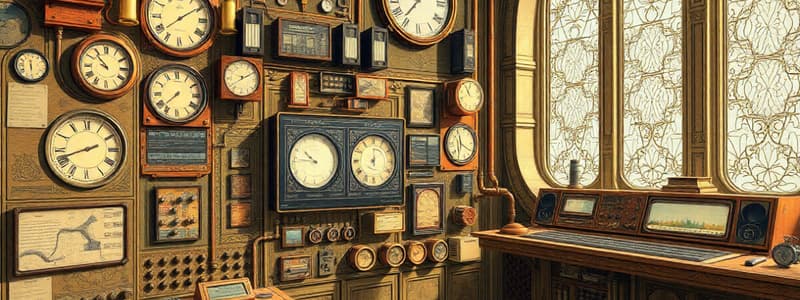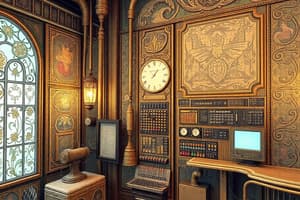Podcast
Questions and Answers
What is the main goal of a bumpless transfer when switching from automatic to manual mode?
What is the main goal of a bumpless transfer when switching from automatic to manual mode?
- To reduce the set point to zero
- To match the set point to the process variable (correct)
- To increase the set point drastically
- To completely turn off the system
How does a direct acting controller operate compared to a reverse acting controller?
How does a direct acting controller operate compared to a reverse acting controller?
- Direct acting controllers increase output when the input increases (correct)
- Direct acting controllers decrease output when the input increases
- Direct acting controllers and reverse acting controllers move in opposite directions
- They function identically in all scenarios
If a controller setting indicates a 2% ratio of a water to feed mixture, how much water is needed for every 100,000 gallons of feed?
If a controller setting indicates a 2% ratio of a water to feed mixture, how much water is needed for every 100,000 gallons of feed?
- 500 gallons of water
- 1,000 gallons of water
- 4,000 gallons of water
- 2,000 gallons of water (correct)
What does the letter 'F' stand for in controller FIC 101?
What does the letter 'F' stand for in controller FIC 101?
Which of the following devices is typically found upstream of the controller in a control loop?
Which of the following devices is typically found upstream of the controller in a control loop?
What is the primary function of a transducer in an instrument control loop?
What is the primary function of a transducer in an instrument control loop?
What is the primary function of a controller in automatic mode?
What is the primary function of a controller in automatic mode?
Bumpless transfer is important because it helps to prevent which of the following issues?
Bumpless transfer is important because it helps to prevent which of the following issues?
What is the term used for the difference between setpoint and process variable?
What is the term used for the difference between setpoint and process variable?
In a cascade control loop, what is the role of a primary controller?
In a cascade control loop, what is the role of a primary controller?
In a reverse acting controller, how does the output respond when the input increases?
In a reverse acting controller, how does the output respond when the input increases?
What happens if the set point is not matched to the process variable during a bumpless transfer?
What happens if the set point is not matched to the process variable during a bumpless transfer?
What does the integral (reset action) function depend on?
What does the integral (reset action) function depend on?
What characteristic is true of a direct acting controller when the temperature input increases?
What characteristic is true of a direct acting controller when the temperature input increases?
How does a derivative (rate action) function assist in controlling processes?
How does a derivative (rate action) function assist in controlling processes?
Which of these statements best describes the relationship between the transmitter and transducer within a control loop?
Which of these statements best describes the relationship between the transmitter and transducer within a control loop?
What happens when an operator switches from manual to automatic control?
What happens when an operator switches from manual to automatic control?
With a 50% proportional band setting, what change in output results from a 10% input change?
With a 50% proportional band setting, what change in output results from a 10% input change?
In a closed instrument control loop, which components are typically present?
In a closed instrument control loop, which components are typically present?
How much is a valve opened when a 6psi pneumatic signal is sent to an 'air to close' valve?
How much is a valve opened when a 6psi pneumatic signal is sent to an 'air to close' valve?
Study Notes
Controllers and Variables
- A controller in manual mode directly controls the valve output.
- In automatic mode, the setpoint controls the valve output.
- Cascade control occurs when one controller manages the output of another.
- The difference between the setpoint (SP) and the process variable (PV) is called the process error or offset.
- FIC 101 is a controller where F stands for flow, I for indicator, and C for control. 101 is the control loop number.
- The current state of the process is known as the process variable.
- The desired state of the process is referred to as the setpoint.
- When switching from manual to automatic control, ensure the process variable and setpoint are aligned.
- A closed instrument control loop uses sensor, transmitter, controller, and final control element (fce).
- An air-to-close valve with a 6 psi pneumatic signal is opened 75%.
Understanding Controllers
- A 100% proportional band control requires a 100% input change for a 100% output change.
- Integral action is the time needed to complete or repeat a corrective action.
- Derivative action determines the rate of change of corrective action required for process variable stabilization.
- A cascade control loop involves a primary controller working with a secondary controller.
- With a 50% proportional band setting, a 10% input change results in a 20% output change.
- Split-range controllers allow one control to move two valves, each responding to a different portion.
- Bumpless transfer refers to smoothly transitioning from automatic to manual control by aligning the setpoint with the process variable.
- Direct-acting and reverse-acting controllers differ in the direction their outputs change relative to their inputs.
- A 2% ratio controller setting requires 2,000 gallons of water for every 100,000 gallons of feed.
- Instruments upstream and downstream of the controller in a loop include the transmitter and the transducer.
Studying That Suits You
Use AI to generate personalized quizzes and flashcards to suit your learning preferences.
Description
This quiz focuses on the fundamental concepts of controllers and variables used in control systems. It covers manual and automatic modes, cascade control, and the importance of aligning setpoints with process variables. Test your understanding of essential definitions and operational details related to controllers and instrumentation.




